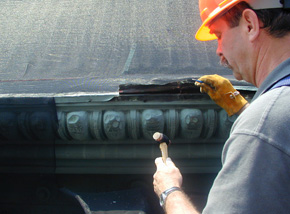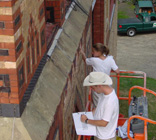- Skip to:
- (M) Main Content
SERVICES
Preservation

RESTORATION AND CONSERVATION
A large part of JHPA’s work involves the creation of architectural drawings and specifications for the restoration and conservation of historic structures, most of which are local, state or national landmarks. Restoration – defined by the Secretary of Interior’s Standards as “the act or process of accurately depicting the form, features, and character of a property as it appeared at a particular period of time…” – typically involves replication of materials, construction methods, and details that serve to present a building as it appeared at a particular period. Depending on the condition of a structure, restoration can involve a large quantity of conservation work designed to save and protect as much of the original building as possible. This could involve epoxy consolidation and repair of original wood timbers and trim elements, cleaning and coating of existing steel, consolidation of masonry, or the improvement of an original detail that is inherently flawed.
HISTORIC PRESERVATION CONSULTING
JHPA’s overall experience in navigating the ins and outs of building preservation for its own projects, combined with the office’s architectural knowledge, allows us to consult to other firms that do not have previous historic preservation experience but may be engaged in large architectural projects with a preservation component. Constructing a new building in an historic district or adding an addition to an existing landmark, can be full of pitfalls and unforeseen demands that, if not anticipated, can cause delay and compromise the success of a project. As a consultant, JHPA works with firms at every level of the design process, acting as a critic and informant to help anticipate conflict and mitigate it. Our office has also developed sets of design standards to help guide design within a given historic context. JHPA also participates in presentations to historic regulatory commissions, boards of trustees and local preservation groups, as well as vetting documents bound for Section 106 review by State Historic Preservation Office.

DOCUMENTATION
In cases where little is known about a building’s history, JHPA has been contracted to physically investigate a structure and document its built history and life. These surveys, called Historic Structure Reports, are crucial first steps in the preservation of historic buildings. Additionally, an HSR is often a required part of grant applications used to secure funding to finance restoration work. Such surveys often include measured drawings of the building, photo documentation, and a prioritized list of recommended work. The assembly of historic and conditions survey work into a graphically coherent whole helps in the interpretation of a structure for restoration purposes and in budgeting for fund-raising efforts. JHPA’s staff is well versed in identifying typical building technologies, materials, and building methods specific to certain periods in the history of the United States. This experience allows them to accurately determine a building’s different construction phases and date its additions and alterations, thereby establishing an accurate building chronology to be used as a baseline to inform decisions regarding interpretation, program, and preservation planning.
CONDITIONS SURVEYING
All buildings are in a perpetual state of decay, but this state is more marked and potentially deleterious in historic buildings. Prioritizing efforts to protect building stock against the inevitable ravages of time, weather, and human impact present a challenge, particularly to owners with multiple buildings and limited personnel to perform maintenance and assess conditions. The majority of JHPA’s projects involve some form of assessment survey to determine a building’s condition before proceeding with any work. In cases where maintenance and preservation efforts have been deferred for long periods and little is known about current conditions, our office has been contracted to prepare written conditions surveys that address interior and exterior architectural fabric as well as structural issues and mechanical and electrical systems. Conditions surveys contain field sketches and color photos, descriptions of building elements and systems, assessment of current function, and recommendations for repair. In order to give building owners and maintenance staff direction in how to best utilize personnel, allot available funds, and raise money for restoration, surveys contain prioritized repair recommendations and a full cost estimate broken out by repair item or phase of work.
- Services Categories
To inquire about JHPA Services, please email info@jhpokorny.com